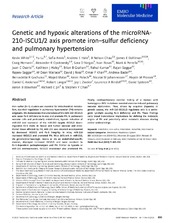Genetic and hypoxic alterations of the microRNA-210-ISCU1/2 axis promote iron-sulfur deficiency and pulmonary hypertension
White, Kevin; Lu, Yu; Annis, Sofia; Hale, Andrew E.; Chau, B. Nelson; Dahlman, James E.; Hemann, Craig; Opotowsky, Alexander R.; Vargas, Sara O.; Rosas, Ivan; Perrella, Mark A.; Osorio, Juan C.; Haley, Kathleen J.; Graham, Brian B.; Kumar, Rahul; Saggar, Rajan; Saggar, Rajeev; Wallace, W. Dean; Ross, David J.; Khan, Omar F.; Bader, Andrew; Gochuico, Bernadette R.; Matar, Majed; Polach, Kevin; Johannessen, Nicolai; Prosser, Haydn M.; Anderson, Daniel G.; Langer, Robert; Zweier, Jay L.; Bindoff, Laurence; Systrom, David; Waxman, Aaron B.; Jin, Richard C.; Chan, Stephen Y.
Peer reviewed, Journal article
Published version

Åpne
Permanent lenke
https://hdl.handle.net/1956/11632Utgivelsesdato
2015Metadata
Vis full innførselSamlinger
Originalversjon
https://doi.org/10.15252/emmm.201404511Sammendrag
Iron–sulfur (Fe‐S) clusters are essential for mitochondrial metabolism, but their regulation in pulmonary hypertension (PH) remains enigmatic. We demonstrate that alterations of the miR‐210‐ISCU1/2 axis cause Fe‐S deficiencies in vivo and promote PH. In pulmonary vascular cells and particularly endothelium, hypoxic induction of miR‐210 and repression of the miR‐210 targets ISCU1/2 down‐regulated Fe‐S levels. In mouse and human vascular and endothelial tissue affected by PH, miR‐210 was elevated accompanied by decreased ISCU1/2 and Fe‐S integrity. In mice, miR‐210 repressed ISCU1/2 and promoted PH. Mice deficient in miR‐210, via genetic/pharmacologic means or via an endothelial‐specific manner, displayed increased ISCU1/2 and were resistant to Fe‐S‐dependent pathophenotypes and PH. Similar to hypoxia or miR‐210 overexpression, ISCU1/2 knockdown also promoted PH. Finally, cardiopulmonary exercise testing of a woman with homozygous ISCU mutations revealed exercise‐induced pulmonary vascular dysfunction. Thus, driven by acquired (hypoxia) or genetic causes, the miR‐210‐ISCU1/2 regulatory axis is a pathogenic lynchpin causing Fe‐S deficiency and PH. These findings carry broad translational implications for defining the metabolic origins of PH and potentially other metabolic diseases sharing similar underpinnings.
